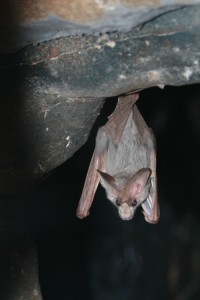Monster Monday: the Ghastly Ghost Bat
October 24, 2016
It haunts caves, crevices, and tunnels by day, emerging only at night to look for victims. You probably would not hear it flying above your head, but you might catch a glimpse of its whitish fur flashing in the moonlight… It is the ghastly ghost bat of Australia.

Australia’s ghost bat. Credit: Liz Lawley (licensed under CC BY-SA 2.0)
Take one look at the ghost bat and you will understand its name. Its large, midnight-black eyes give it a spooked look and, in some regions, its fur is ghoulishly pale. It has large, filmy ears and a leaflike nose poking out from its creepy-looking head. Like many bats, however, ghost bats are almost cute—and not terribly big. An adult can reach about 5 inches (13 centimeters) in length, and its milky, clear wings can spread to about 20 inches (50 centimeters).
The ghost bat is one of the most carnivorous (flesh-eating) of all bats. The diets of most other bat species (kinds) consist of fruit, insects, or sometimes the blood of living animals. The ghost bat, however, specializes in eating frogs, lizards, birds, and other small animals. With a swift and silent swoop, it drops onto its prey, enclosing the victim in its wings and killing it with bites to the head and neck. It then flies to an eating spot, carrying the entire animal with its feet. A ghost bat can kill and carry prey that weighs up to 80 percent of its own weight. When it is time to eat, the ghost bat will consume nearly every part of its victim, including bones, fur, and feathers.
The thought of ghost bats gliding in the night might be spine-tingling, but like other bats, their fearsome reputation is mostly undeserved. Ghost bats do not attack human beings and will avoid contact with people if they can. In fact, ghost bats are vulnerable to the destruction and disturbances humans create in the bats’ natural habitat. Repeated visits by humans can cause a colony of ghost bats to abandon a cave, and mining activities have destroyed many of their roosting sites. Because these bats often rely on vision and hearing more than echolocation during flight, they often die from crashing into such hard-to-see obstacles as barbed wire fences and electric power lines. In echolocation, a bat uses echoes of sounds it produces to collect information about its surroundings. Ghost bats also often fall prey to hunting cats and foxes. It is up to people to save our small, spooky friends by protecting the caves, tunnels, and hunting grounds that ghost bats call home.


